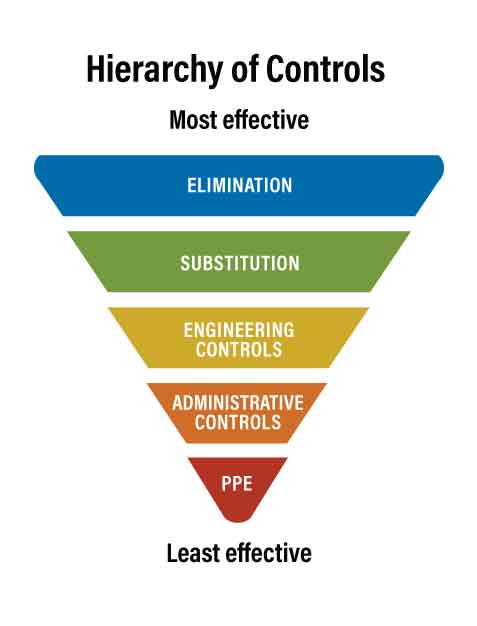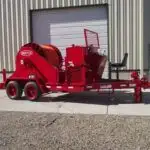Hierarchy of Hazard Controls OSHA Explained
By R.W. Hurst, The Electricity Forum

CSA Z462 Arc Flash Training - Electrical Safety Essentials
Our customized live online or in‑person group training can be delivered to your staff at your location.

- Live Online
- 6 hours Instructor-led
- Group Training Available
Download Our OSHA 3873 Fact Sheet – Minimum Approach Distance and Training Requirements

- Calculate MAD using voltage and overvoltage values
- Ensure proper communication between host and contract employers
- Meet OSHA training requirements for qualified electrical workers
The hierarchy of hazard controls (OSHA) is a system that ranks safety measures to reduce workplace risks. It prioritizes elimination, substitution, engineering controls, administrative controls, and PPE to protect workers from hazards. This method improves compliance and injury prevention.
What is the Hierarchy of Hazard Controls (OSHA)?
The OSHA hierarchy of hazard controls is a ranked system used to minimize or eliminate workplace hazards. It follows a top-down approach:
✅ Eliminates or substitutes hazards at the source when possible
✅ Uses engineering and administrative controls to reduce exposure
✅ Relies on PPE only when other methods aren't feasible
Request a Free Training Quotation
The hierarchy of hazard controls, as outlined by OSHA, is a foundational concept in occupational safety, guiding employers and safety professionals in minimizing or eliminating workplace hazards. Developed by the National Institute for Occupational Safety and Health (NIOSH) and adopted by OSHA, this hierarchy ranks safety controls from the most effective to least effective, providing a structured approach to hazard management, including a combination of control methods, including administrative controls and personal protective equipment. For a practical guide to implementation, see our 7 Steps to Arc Flash Analysis, which integrates risk assessment and hazard mitigation strategies.
What are the Five Levels?
The hierarchy of hazard controls consists of five levels, each representing a different strategy for controlling hazards:
-
Elimination: Removing the hazard entirely from the workplace.
-
Substitution: Replacing a hazardous substance or process with a less hazardous one.
-
Engineering Controls: Isolating people from the hazard using physical changes to the workplace.
-
Administrative Controls: Changing work practices and procedures to reduce exposure to hazards.
-
Personal Protective Equipment (PPE): Using equipment to protect workers from exposure.
What is the Most Effective Hazard Mitigation Strategy?
The most effective level in the hierarchy of hazard controls is elimination. By completely removing the hazard, there is no risk of exposure to workers. For instance, automating a process to eliminate human interaction with hazardous machinery is a prime example of elimination. Learn how PPE fits into the hierarchy by browsing our Arc Flash PPE Category, including ratings and selection standards.
Test Your Knowledge About Arc Flash!
Think you know Arc Flash? Take our quick, interactive quiz and test your knowledge in minutes.
- Instantly see your results and score
- Identify strengths and areas for improvement
- Challenge yourself on real-world electrical topics
What are the Four Control Techniques that Comprise the Hierarchy of Controls?
The four primary control techniques within the hierarchy of controls are:
-
Elimination or Substitution: Removing the hazard or replacing it with something less harmful.
-
Engineering Controls: Implementing physical changes such as machine guarding or ventilation systems.
-
Administrative Controls: Modifying work practices, schedules, and procedures to limit exposure.
-
Personal Protective Equipment (PPE): Providing equipment like gloves, masks, and helmets to protect workers.
OSHA’s guidelines for hazard control are directly linked to 29 CFR 1910.147, which outlines lockout/tagout requirements for hazardous energy control.
How Does Elimination Differ from Substitution?
Elimination and substitution are the top two levels. Elimination involves completely removing the hazard from the workplace, ensuring no potential for exposure. Substitution, on the other hand, involves replacing a hazardous substance or process with one that poses a lower risk. For example, using water-based paints instead of solvent-based paints is a form of substitution. While both methods aim to reduce risk, elimination is more effective as it entirely removes the hazard. Explore the importance of engineering controls in arc flash scenarios by reviewing our Arc Flash Assessment Software page.
How Can Employers Implement the Hierarchy of Hazard Controls in Their Workplace?
Employers can implement the hierarchy through a systematic approach:
-
Conduct Hazard Assessments: Identify and evaluate hazards in the workplace.
-
Prioritize Controls: Apply the hierarchy, starting with elimination and substitution where possible.
-
Implement Engineering Controls: Install safety features such as machine guarding, ventilation, and noise control systems.
-
Develop Administrative Controls: Establish safe work practices, training programs, and preventive maintenance schedules.
-
Provide PPE: Ensure workers have access to and use the necessary personal protective equipment.
Employers should also foster a safety culture by involving employees in safety planning and continuously monitoring the effectiveness of implemented safeguards. To align with OSHA enforcement on control methods, check out our article on Is Arc Flash Analysis Required by OSHA.
Why is PPE Considered Least Effective in the Hierarchy?
PPE is considered the least effective control because it does not eliminate or reduce the hazard itself. Instead, it relies on the worker's consistent and correct use of the equipment to prevent exposure. PPE is often seen as a last line of defence, used when other measures are not feasible or sufficient. Additionally, PPE can be uncomfortable, impair job performance, and require regular maintenance and replacement.
How Does OSHA Enforce the Implementation?
OSHA enforces the implementation of the hierarchy through regulations, inspections, and citations. OSHA standards often mandate specific safety measures for hazardous chemicals, machinery, and work environments. During inspections, it evaluates whether employers are using the most effective measures to protect workers. Employers failing to comply with these standards may face citations and penalties. Additionally, it provides guidance, resources, and training to help employers understand and apply the safety measures.
The hierarchy of hazard controls, as outlined by OSHA, is a vital framework for ensuring workplace safety, guiding employers to protect workers from hazards effectively. By prioritizing measures from elimination to PPE, employers can create safer work environments and promote long-term health and safety. Understanding and implementing this hierarchy is essential for mitigating risks and safeguarding employees. For a broader understanding of regulatory alignment, see our section on NFPA 70E Arc Flash Training, which emphasizes compliance and safety best practices.
Contact us to learn more about our courses or request a free quotation.
Related Articles:








